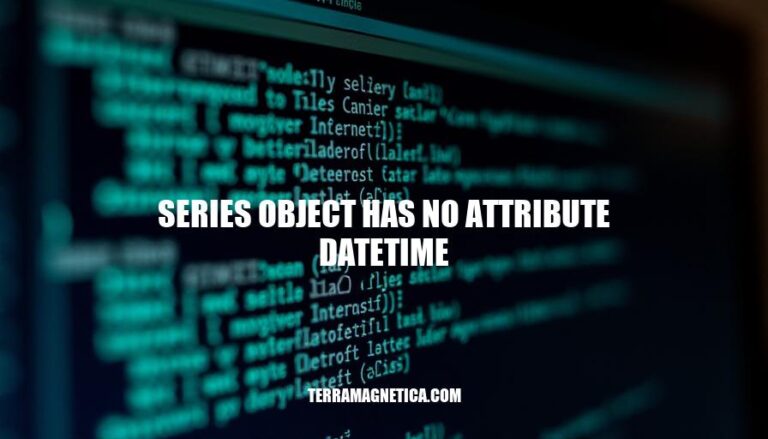


When working with pandas in Python, you might encounter the error 'Series' object has no attribute 'datetime'. This typically happens when you try to use datetime-specific methods on a pandas Series without converting it to a datetime object first. Understanding how to properly handle datetime data in pandas can help you avoid this common issue.
The error 'Series' object has no attribute 'datetime' occurs when you try to access a datetime attribute that doesn’t exist on a pandas Series object.
A pandas Series is a one-dimensional array-like object that can hold various data types, including integers, floats, strings, and datetime objects. It’s similar to a column in a DataFrame.
index, values, dtype, namehead(), tail(), mean(), sum(), apply()This error often happens when you try to use datetime-specific methods directly on a Series without using the .dt accessor. For example, instead of series.datetime, you should use series.dt to access datetime properties and methods.
If you need to convert a Series to datetime, use pd.to_datetime(series).
Here are common scenarios that lead to the 'Series' object has no attribute 'datetime' error in pandas:
pd.to_datetime() directly on a Series instead of converting the Series to a DataFrame first.datetime instead of to_datetime.strftime is not a method for Series.pd.to_datetime() to convert a Series of strings to datetime objects.Here’s a step-by-step guide to troubleshoot and resolve the 'Series' object has no attribute 'datetime' error in Python:
This error occurs when you try to use a datetime method directly on a Pandas Series object. Series objects do not have a datetime attribute.
Ensure your Series contains datetime objects. Use pd.to_datetime() to convert the Series.
import pandas as pd
# Example Series
dates = pd.Series(['2023-01-01', '2023-02-01', '2023-03-01'])
# Convert to datetime
dates = pd.to_datetime(dates)
.dt AccessorOnce the Series is converted to datetime, use the .dt accessor to access datetime properties and methods.
# Extract year
years = dates.dt.year
print(years)
If you need to apply a datetime method, use the .dt accessor or apply() method.
# Using .dt accessor
formatted_dates = dates.dt.strftime('%Y-%m-%d')
print(formatted_dates)
# Using apply() method
formatted_dates = dates.apply(lambda x: x.strftime('%Y-%m-%d'))
print(formatted_dates)
If your Series cannot be converted to datetime, handle the error appropriately.
try:
dates = pd.to_datetime(dates)
except Exception as e:
print(f"Error converting to datetime: {e}")
Here’s a complete example:
import pandas as pd
# Example Series
dates = pd.Series(['2023-01-01', '2023-02-01', '2023-03-01'])
# Convert to datetime
try:
dates = pd.to_datetime(dates)
except Exception as e:
print(f"Error converting to datetime: {e}")
# Extract year using .dt accessor
years = dates.dt.year
print("Years:", years)
# Format dates using .dt accessor
formatted_dates = dates.dt.strftime('%Y-%m-%d')
print("Formatted Dates:", formatted_dates)
# Format dates using apply() method
formatted_dates_apply = dates.apply(lambda x: x.strftime('%Y-%m-%d'))
print("Formatted Dates with apply:", formatted_dates_apply)
This should help you troubleshoot and resolve the 'Series' object has no attribute 'datetime' error effectively!
To avoid the 'Series' object has no attribute 'datetime' error in future projects, follow these best practices:
Convert Series to Datetime Properly:
pd.to_datetime(series) instead of series.to_datetime() to convert your Series to datetime objects.Use the .dt Accessor:
.dt accessor. For example, series.dt.year.Avoid Direct Method Calls on Series:
strftime should be used with the .dt accessor, e.g., series.dt.strftime('%Y-%m-%d').Ensure Proper Datetime Parsing:
parse_dates in functions like pd.read_csv().Implement Error Handling:
By following these practices, you can handle datetime data more effectively and avoid common pitfalls in pandas.
The ‘Series’ object has no attribute ‘datetime’ error occurs when you try to access datetime properties on a pandas Series that hasn’t been converted to datetime objects.
pd.to_datetime() or ensure they are in a format that can be parsed by pd.to_datetime().pd.to_datetime().By following these practices, you can handle datetime data more effectively and avoid common pitfalls in pandas.